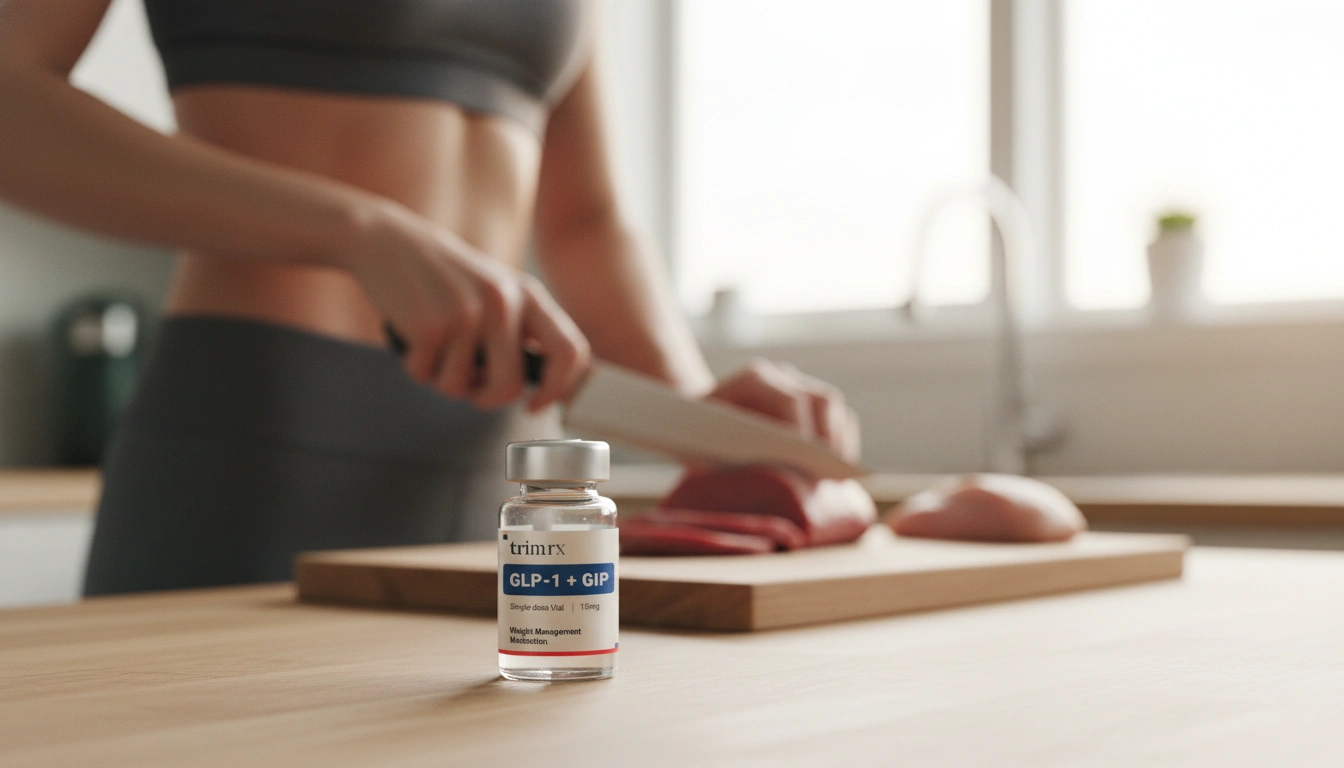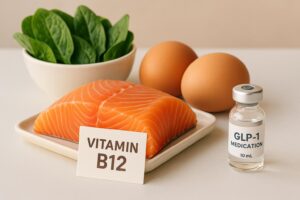How to Boost GLP-1 with Food: A Comprehensive Guide

Introduction
Did you know that a simple change in your diet could potentially transform your body’s ability to manage hunger and blood sugar levels? The hormone glucagon-like peptide-1 (GLP-1) has garnered significant attention in recent years, particularly due to its crucial role in appetite regulation and metabolic health. GLP-1 is produced in the gut after we eat, and it plays a vital role in stimulating insulin secretion, slowing gastric emptying, and promoting a feeling of fullness.
In our pursuit of healthier lifestyles, understanding how to naturally enhance GLP-1 levels through food can be a game changer. This blog post will explore the various foods that can boost GLP-1 production, the science behind their effects, and practical ways to incorporate them into our daily diets. By the end of this post, we hope to empower you with actionable insights that can aid in your weight management and overall well-being journey.
Together, we will delve into the relationship between diet and GLP-1, identify specific foods that promote its release, and discuss how these dietary choices can support our health objectives. We’ll also address common misconceptions and provide you with a clear action plan to improve your GLP-1 levels naturally.
Here’s a sneak peek of what to expect: we will cover the key functions of GLP-1, the types of foods that can increase its levels, the role of fiber and healthy fats, and how to create delicious, GLP-1-boosting meals. Let’s embark on this journey toward better health!
Understanding GLP-1 and Its Role in Metabolism
GLP-1 is a hormone produced by the enteroendocrine cells in the gut. Its primary functions include:
- Stimulating Insulin Secretion: GLP-1 enhances the secretion of insulin in response to food intake, which helps lower blood sugar levels.
- Inhibiting Glucagon Release: It reduces the release of glucagon, a hormone that raises blood sugar, thereby contributing to better blood sugar control.
- Slowing Gastric Emptying: GLP-1 slows down the rate at which food leaves the stomach, extending the feeling of fullness.
- Regulating Appetite: It signals the brain to reduce hunger, which can help in managing food intake and preventing overeating.
Understanding these functions highlights the importance of maintaining optimal GLP-1 levels, especially for those looking to manage their weight or improve metabolic health.
The Connection Between Food and GLP-1
Recent research has shown that certain dietary components can stimulate the release of GLP-1. The foods we consume influence not only our overall health but also the production of hormones like GLP-1. Here are key dietary elements that can enhance GLP-1 secretion:
1. Fiber-Rich Foods
Fiber plays a significant role in boosting GLP-1 levels. When we consume foods high in soluble fiber, they are fermented by gut bacteria, producing short-chain fatty acids (SCFAs). These SCFAs can stimulate GLP-1 release and promote satiety.
Foods High in Soluble Fiber Include:
- Oats: Rich in beta-glucan, a type of soluble fiber known to increase GLP-1 secretion.
- Barley: Another excellent source of beta-glucan, which supports GLP-1 and improves insulin sensitivity.
- Legumes: Beans, lentils, and peas are high in fiber and protein, both of which can enhance GLP-1 levels.
- Fruits: Apples, pears, and citrus fruits contain soluble fiber that can stimulate GLP-1 production.
2. Healthy Fats
Incorporating healthy fats into our diets can significantly influence GLP-1 levels. Unsaturated fats, particularly those found in plant-based sources, are more effective at stimulating GLP-1 than saturated fats.
Sources of Healthy Fats Include:
- Avocados: High in monounsaturated fats and fiber, avocados are excellent for GLP-1 secretion.
- Olive Oil: Rich in unsaturated fats, olive oil can enhance GLP-1 release and improve insulin sensitivity.
- Nuts and Seeds: Almonds, walnuts, and chia seeds provide healthy fats and fiber, contributing to increased GLP-1 levels.
3. Protein Sources
Protein is another key nutrient that plays a role in GLP-1 secretion. Certain amino acids found in protein-rich foods can stimulate the release of GLP-1.
Lean Protein Options Include:
- Eggs: A great source of high-quality protein; studies suggest they can enhance GLP-1 secretion.
- Fish: Particularly fatty fish like salmon, which are rich in omega-3 fatty acids that may increase GLP-1 levels.
- Poultry: Chicken and turkey provide lean protein that supports GLP-1 production.
Practical Ways to Boost GLP-1 with Food
Now that we understand the types of foods that can increase GLP-1 levels, let’s explore practical strategies for incorporating these foods into our diets effectively.
Create Balanced Meals
When planning meals, aim to include a combination of high-fiber foods, healthy fats, and lean proteins. This not only supports GLP-1 production but also helps maintain balanced blood sugar levels and promotes satiety.
Sample Meal Ideas:
- Breakfast: Scrambled eggs with avocado and a side of steel-cut oats topped with berries.
- Lunch: A quinoa salad with black beans, mixed greens, diced veggies, and a drizzle of olive oil.
- Dinner: Grilled salmon with roasted Brussels sprouts and a barley pilaf.
Mindful Eating Practices
The way we eat can also influence GLP-1 secretion. Engaging in mindful eating—taking time to savor each bite and listen to our hunger cues—can promote better digestion and hormonal responses.
- Slow Down: Aim to take at least 20-30 minutes to enjoy meals, which allows time for GLP-1 to be released and signals to be received by the brain.
- Focus on Meals: Avoid distractions like screens during meals to help enhance the eating experience and support digestion.
Incorporate Prebiotics and Probiotics
Supporting gut health is essential for optimizing GLP-1 levels. Prebiotics feed beneficial gut bacteria, while probiotics introduce more of these helpful bacteria into the gut.
- Prebiotic Foods: Include garlic, onions, asparagus, and bananas in your meals to provide prebiotic fibers that support gut health.
- Probiotic Sources: Yogurt, kefir, and fermented foods like sauerkraut can help maintain a balanced gut microbiome.
The Role of Exercise in Enhancing GLP-1
While diet plays a significant role in boosting GLP-1, physical activity is another essential component. Regular exercise has been shown to elevate GLP-1 levels, contributing to improved insulin sensitivity and appetite regulation.
- Aim for Consistency: Strive for at least 150 minutes of moderate-intensity exercise each week, including both aerobic and resistance training.
- Incorporate Variety: Include a mix of cardiovascular, strength training, and flexibility exercises to support overall health.
Addressing Common Misconceptions
As we navigate the relationship between food and GLP-1, it’s essential to address some common misconceptions.
- Dietary Fiber Is Not Created Equal: Not all fibers are equally effective at boosting GLP-1. Focus on soluble and fermentable fibers for the best results.
- Supplements vs. Whole Foods: While some supplements claim to boost GLP-1, whole foods provide a complex array of nutrients that support overall health and hormonal balance.
- GLP-1 Medications vs. Dietary Changes: Prescription medications like semaglutide can effectively raise GLP-1 levels, but dietary changes are a safe and sustainable way to support GLP-1 production naturally.
Conclusion
Boosting GLP-1 levels through food is a practical and effective strategy for improving appetite regulation and metabolic health. By incorporating high-fiber foods, healthy fats, and lean proteins into our diets, we can enhance GLP-1 secretion and support our weight management goals.
As we continue our journey toward healthier lifestyles, let us embrace the power of food and mindful eating practices to optimize our well-being. Remember, every meal is an opportunity to nourish our bodies and enhance our health.
FAQ
What is GLP-1, and why is it important?
A1: GLP-1 is a hormone produced in the gut that helps regulate blood sugar levels, stimulates insulin secretion, and promotes a feeling of fullness. It plays a critical role in appetite regulation and metabolic health.
What foods can boost GLP-1 levels?
A2: Foods high in soluble fiber (like oats, legumes, and fruits), healthy fats (such as avocados and olive oil), and lean proteins (like eggs and fish) can enhance GLP-1 secretion.
Can exercise help increase GLP-1 levels?
A3: Yes, regular physical activity can elevate GLP-1 levels, contributing to improved insulin sensitivity and appetite regulation.
How can I incorporate more fiber into my diet?
A4: Opt for whole grains, legumes, fruits, and vegetables. Start by adding a serving of fiber-rich food to each meal and gradually increase your intake.
Is it necessary to take supplements to boost GLP-1?
A5: Whole foods provide a more comprehensive range of nutrients that support GLP-1 production and overall health. While some supplements may help, focusing on a balanced diet is generally more beneficial.
As you explore ways to boost your GLP-1 naturally, consider taking our free assessment quiz at TrimRx to find personalized weight loss solutions that resonate with your health goals. Together, we can achieve sustainable weight loss through science and empathy.

Transforming Lives, One Step at a Time
Keep reading
Vitamin B12 and GLP-1 Medications: What to Know
GLP-1 medications can lower B12 absorption and intake; learn symptoms, food sources, supplement options, and how to monitor levels.
Semaglutide Injection Site Reactions: What To Know
Learn why semaglutide injections can cause redness, swelling or nodules, how to prevent and treat them, and when to seek medical care.
TrimRx vs Friday’s
Compare TrimRx and Friday’s telehealth GLP-1 weight-loss programs: pricing, medical support, coaching, delivery, and which fits your needs.



